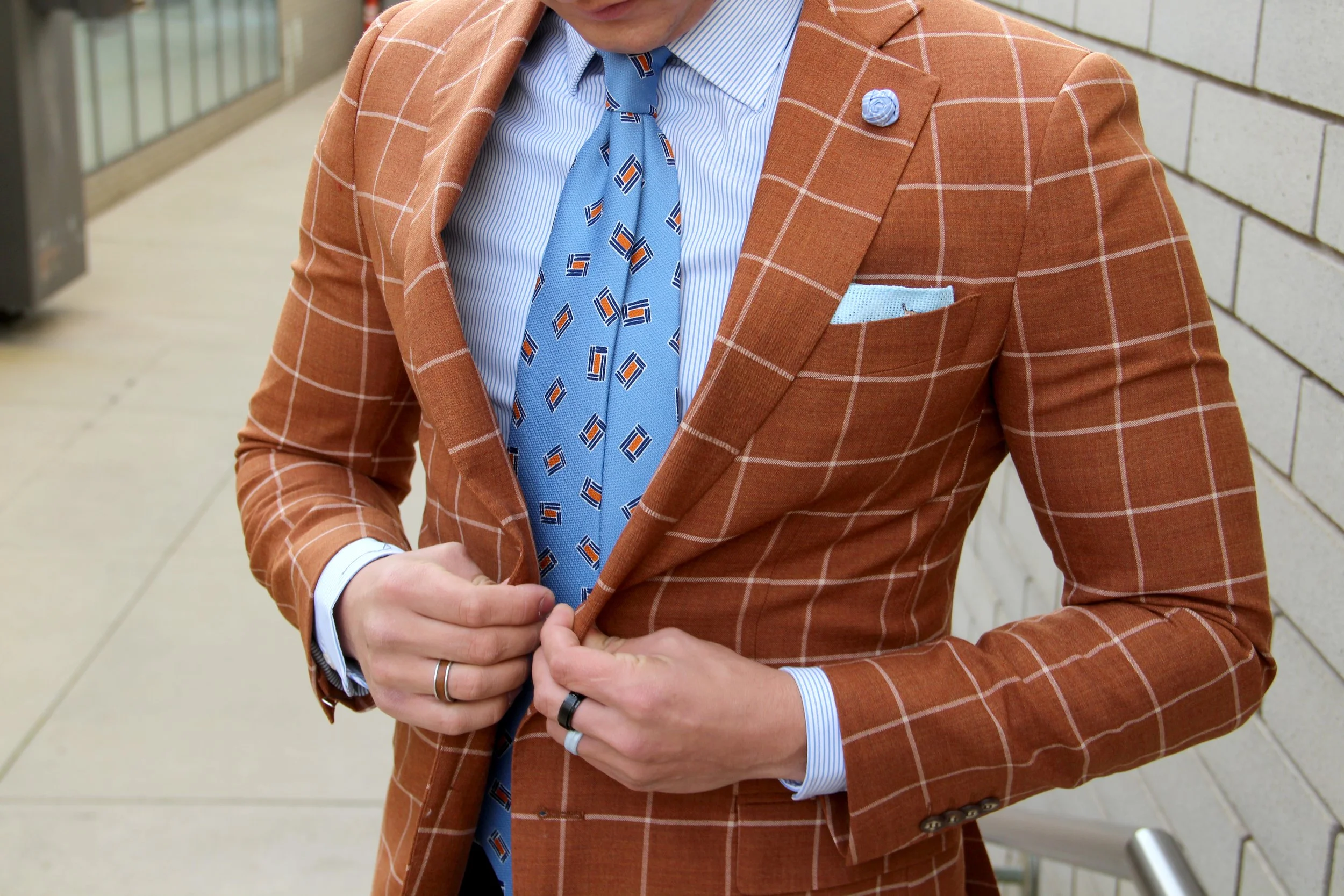You can tell a suit is right sometime around late afternoon. Not at the mirror before you leave, but after the commute, the meetings, the stairs you forgot existed, and the coffee you carried a little too fast. The fabric still falls where it should, the collar stays home, the lapel isn’t pleading for attention. Good fit isn’t dramatic; it’s dependable.
Think of it like tuning, not tightening. A jacket that’s tuned to your posture and habits settles the moment you stop moving, the way a well-made door finds its frame. Shoulders carry the weight without complaint, sleeves follow your reach without tugging the body, trousers keep their line when you sit and recover the second you stand. How should a suit fit? Start with this: by evening, it should look as composed as it did at nine—without you having to think about it. That’s the standard.
Peaks, Notches, and the Face — What Lapels Really Do
We talk about lapels as if they were decorations. They aren’t. Lapels frame the face, steer the eye, and set the tone before a single word is spoken. The conversation around peak lapels vs notch lapels is less taxonomy than temperament. Peak lapels sharpen a line; they carry intent. Notch lapels soften it; they default to ease. Neither is “right” in all contexts—each changes what the upper half of a jacket communicates.
Proportion is the silent engine behind this. A higher gorge (where lapel meets collar) lifts the face and reads contemporary; a lower gorge settles the line and can feel more relaxed, even nostalgic. Lapel width should echo the wearer’s architecture—broader shoulders and a substantial chest can carry a wider lapel without swallowing the face, while a slimmer frame benefits from restraint. The goal isn’t trend, it’s equilibrium. When the lapel width harmonizes with shoulder breadth and tie blade (if you wear one), the whole front of the coat resolves.
This is where fit meets design. You can tailor a jacket beautifully, but if the lapel fights the wearer’s features, the coat will always feel a little off. Conversely, a modest alteration can look transformative if the underlying design flatters the head-and-shoulder line. Asking how should a suit fit inevitably touches the lapel conversation because lapels are the suit’s accent—too loud and they drown you out, too faint and the face loses presence.
Texture and roll matter as well. A healthy lapel roll—particularly on a soft three-roll-two—signals ease the moment you exhale. It’s not a gimmick; it’s the lapel returning to its natural curve, the cloth’s way of saying it remembers where it belongs. Pair that with a gorge that doesn’t crowd the neck and a lapel that clears the chest without flashing white shirt in excess, and the jacket reads calm even while you’re moving.
And yes, small choices add up. A lapel pin can focus attention near the face, which is where you want it. But the best ones know when to leave well enough alone. The lapel is already doing subtle work—framing, guiding, balancing. If an accessory crowds the roll or fights the notch, it breaks the spell. Think of adornments like punctuation in a sentence: useful, but only if they serve the thought.
The Line of the Body — Button Stance, Placement, and Ease
Look at the front of a jacket and you’ll see the letter V. Where that V meets—the point where the coat closes—isn’t arbitrary. Suit button stance shapes the torso: too high and the chest feels pinched; too low and the waist loses definition. Get it right and the line from shoulder to waist and back out to the skirt feels inevitable, as if the jacket were drafted from your ribcage out.
We get asked all the time, how does button placement affect fit beyond looks? In motion. A stance set at your natural waist allows the fronts to relax when you sit and to fall back into place when you stand. It controls how the lapel opens as you gesture and whether the quarters flare or rest. With a two-button coat, the higher button is the anchor; the lower is there to keep the fronts honest. On a three-roll-two, the hidden top button and gentle roll create a longer line that reads relaxed but still composed. These are engineering choices, not fashion tricks.
Button placement also governs “breathing room” through the ribs. If the stance is too high, the jacket can pull when you reach; too low and the coat collapses at the midsection. A well-placed button stance allows a shaped waist without the dreaded “X” across the fronts. You should be able to button the coat, take a deep breath, and feel the fronts rest—not strain, not gape, just rest. That resting state is the visual cue people read as confidence.
There’s choreography in the back, too. Vents are not afterthoughts; they’re a plan for how the jacket behaves when seated. A single vent opens centrally and can reveal more of the seat; double vents peel back just enough and return without fuss when you stand. If vents fight your stride or stick open after you sit, something in the balance—stance included—needs attention.
Finally, remember the jacket’s relationship to trousers. Placement at the front dictates how much shirt shows when you move. A stance too low paired with a low rise creates a flashing triangle of shirt at every reach; a stance positioned correctly over a slightly higher rise keeps the line clean. Fit is a team sport—front closure, lapel roll, and trouser rise are collaborators, not strangers.
Small Signals, Big Difference — The Lapel Pin and Other Noticeable Choices
There’s a reason subtle choices loom large in good tailoring: they refine the read without rewriting the sentence. The lapel pin is the easiest example. Placed with intention (and restraint), it draws the eye to the face, anchors the upper half, and—if there’s sentiment attached—says something about the wearer without spelling it out. Placed carelessly, it interrupts the lapel roll, clutters the line, and fights the message the jacket is trying to send.
Cuff and collar are similar quiet signals. A collar that sits against the neck while you turn your head tells you the back balance is right. If the collar hikes when you reach forward, the coat is asking for a small alteration—often millimeters make the difference. Sleeve length that shows a whisper of shirt (not a proclamation) sharpens the hand without fuss. If your sleeves twist or sprout diagonal creases, the pitch likely needs to match your natural stance. None of this is spectacle; it’s housekeeping. And it’s what makes a suit look composed at 8 a.m. and still composed at 8 p.m.
Buttons on the sleeve—whether working or not—also send a message. Surgeon’s cuffs function, yes, but more importantly they speak to make. They aren’t a requirement of quality (plenty of excellent coats omit them), but when present and proportioned well, they tell you the pattern drafter cared enough to align utility with design. That same care applies to spacing: crowded cuff buttons make even a correct sleeve look anxious; generous spacing lets the line breathe.
Remember, we’re not encouraging a scavenger hunt of “features.” The question behind all these small decisions remains how should a suit fit in the whole: collar calm, lapel unhurried, fronts at ease, trousers in partnership. A tasteful lapel pin belongs to that whole, not above it. The details matter because they cooperate. That’s where the impression of effortlessness comes from—structure doing its job so you don’t have to think about it.
How Should a Suit Fit? Reading Proportion at a Glance
In the end, you can read fit the way a tailor does: in a few quiet checks that take seconds and tell you everything.
Start at the shoulder. Does the jacket meet your own shoulder without collapsing or overhanging? If the sleeve cap is smiling or frowning, the relationship is off. Move to the collar. Turn your head, reach forward, stand tall. The collar should stay home against the shirt; if it gaps, the back balance is asking for help.
Now the chest. You want unforced drape—enough room for breath without puddles of cloth. Button the coat and look for peace across the fronts. If you see an “X” stretching from button to shoulder, you’re negotiating with physics. Let the waist shape, but don’t let it strangle. Fit should trace the torso, not carve it.
Check the suit button stance by feeling—not just looking. Where the jacket closes should align with where your torso wants to hinge. When you sit, the fronts should relax instead of pleading. As you stand, they should fall back into place with one subtle gesture of the hand (or none at all). How does button placement affect fit over a day? That’s the answer: it sets the rhythm of every movement.
Arms tell the truth. If sleeves twist, the pitch isn’t matching your natural posture. If cuffs swallow your hands or flash too much shirt, length is off—but so might be the angle at which your arms hang. Those small calibrations are why good alterations feel like exhale.
Trousers, finally. Rise at your natural waist keeps the waistband home when you sit, which keeps your shirt in place and your line unbroken. A touch of room in the thigh prevents stress creases and lets the leg fall clean. Hem to a break that suits your shoes and stride. The point is not a set of rules; it’s a set of relationships that behave well together.
If you’re still thinking about the suit an hour after dressing, it’s not finished yet. If you forget about it—and others keep thinking you look unusually composed—you’ve found it. That’s the answer to how should a suit fit when it’s done properly: like something designed for your life, not just your mirror.




